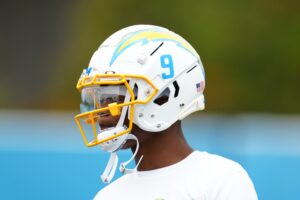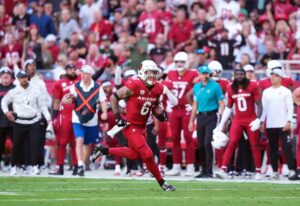Welcome to the third and final installment of who the Giants should take with the 23rd pick. In the last two articles I went over the offensive tackle and linebacker prospects for the New York Giants. Here I’ll be discussing the tight ends.
The Giants haven’t had a franchise caliber tight end since they traded Jeremy Shockey to the New Orleans Saints a decade ago. How can that be? To start, the team tried grooming players like Kevin Boss and Jake Ballard who never reached the potential fans were hoping for. Since then they’ve been cycling through tight-ends, year after year, trying to find one that fits.
Luckily, this might come to an end. The 2017 draft is loaded at tight end and there are two that have been rumored as possible prospects for the Giants first round pick. Those two are Alabama’s O.J. Howard and Miami’s David Njoku.
I’ll be looking at four categories to determine which tight-end is the best fit for the Giants in the first round. First, I’ll look at their basics. That includes their height, weight, athletic ability and accolades. Secondly is their receiving ability. Next is their blocking ability. Lastly, I’ll be looking at any intangibles, overall grade and scheme fit.
Who Should the New York Giants Draft With the 23rd Pick? Tight End Edition
Basics
Considering I’ve started every comparison I’ve done this year with an Alabama player, I might as well continue the trend. O.J. Howard is a rare physical specimen. He comes in at 6’6″ and weighing 251 pounds. What makes him rare is that he is freakishly athletic for someone that size. At the Combine he ran a 4.51 second 40-yard dash and a 6.85 second three-cone drill. That’s a 40 time you’d expect to see on a running back and a three-cone that beat most edge rushers. People that big shouldn’t be able to move that fast! That speed, combined with the other skills we’re going to go over led him to being a John Mackey Award finalist this year, the award given to the nation’s best tight-end. He was also named third team All-American and second team All-SEC.
In any other year, David Njoku would be the best athlete among tight ends. This year he may not even be second. That’s how deep this class is. Njoku comes in at 6’4″ and weighing 246 pounds. His 40-yard dash time and three-cone drill time, although very good, were not as impressive as Howard’s, coming in at 4.61 seconds in the 40 and 6.97 seconds in the three-cone. Njoku had a better statistical season as in 2016 than Howard, yet he didn’t get any accolades for his performance.
Receiving Ability
David Njoku finished the year with almost 700 yards and eight touchdowns, good numbers for a college tight-end.
|
2016 Receiving Stats |
|||||
| Player | Team | Pos. | Rec. | Yards | TD |
| Njoku, David | Miami | TE | 43 | 698 | 8 |
| Howard, OJ | Alabama | TE | 45 | 595 | 3 |
Those statistics matchup with his receiving ability. As previously mentioned, he’s an excellent athlete. He turned that athleticism into crisp route running and good separation skills. He’s quick off the line, and when he can’t get separation, he’ll catch the ball in traffic. His catch radius is good but he’s better at catches in traffic than he is at circus catches. His hands, although excellent in traffic, were inconsistent. He dropped some easy passes in 2016. When he does catch it, he’s a beast to take down with the ball in his hands. Not only will he run over a defender, he has the balance to keep going and pick up more yards. He’s and offensive mismatch and a future NFL star as a receiver.
Howard didn’t have the kind of year that Njoku had as a pass catcher. He still showed he can do phenomenal work, but the offense he was in didn’t allow him to show his true potential. He didn’t run too many different routes and he didn’t attempt many difficult catches on film. However, he showed excellent separation skills, mainly due to his running back level speed, and reliable hands. He’s not as good as Njoku after contact, but he’s more explosive and can take anything he catches to the house.
Blocking Ability
Where Howard really separates himself is in his ability as a blocker. When it comes to in-line run blocking he does a good job. He needs to drive his feet more, but overall he’s good. His ability to block in space and his awareness is excellent. What’s most impressive though is his pass blocking ability. I saw him go up against Houston’s Tyus Bowser at the Senior Bowl practices. Bowser, who is known for being an effective pass rusher, got stalemated by Howard. Howard mirrored every move and treated him like he was nothing more than a scrub. Tight-ends don’t have this kind of ability to pass block, except for him.
Njoku isn’t as good of a blocker as Howard. He was average in both blocking the run and pass. He did better when lined up wide where he could stalk block defensive backs, but tight ends should be able to hold their own when lined up tight. He does have excellent awareness, which he uses to get his defender to go where he wants. However, if his defender is smart, he can beat Njoku right across his face without much of a problem.
Summary
The Giants under Ben McAdoo have been running more of a spread/west coast type offense. The tight end the Giants take in the first round should reflect this new philosophy they have: a tight end that is more of a receiver than a blocker. So with that, who should the Giants take with the 23rd pick? If he’s available, it has to be O.J. Howard. However, Howard is expected to go earlier. With that in mind, the Giants may need to somehow figure out a way to trade up to get him.
Njoku showed better receiving skills in college, but I don’t think we’ve seen the full extent of what Howard is capable of. Howard, like I mentioned before, is an elite athlete and a better player. Njoku’s extra 100 receiving yards were not enough to justify taking him before Howard. However, both of these players are going to be excellent pros and there is a chance that OJ Howard isn’t there for the Giants at 23. If not, I would be perfectly happy with them taking Njoku. Either way, the Giants will have a franchise-caliber tight end they haven’t had in a decade.






